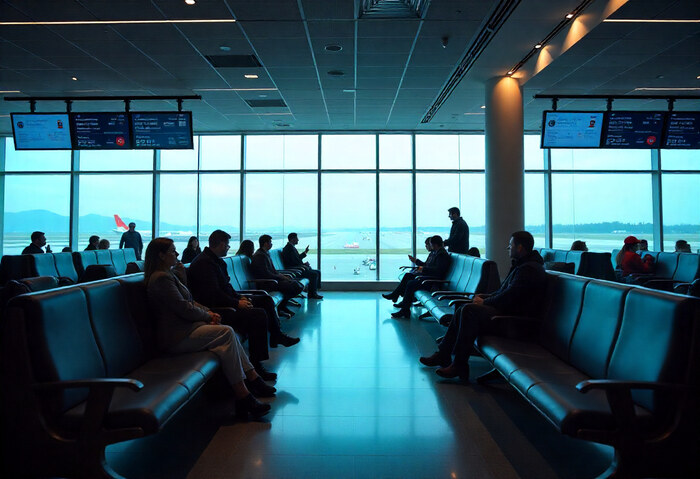Home » AIRLINE NEWS » Mexico, Canada, UK, Germany, and Dominican Republic Dominate U.S. Travel Routes While Inbound Visitors Decline and Outbound Travel Hits New Heights
Published on
September 20, 2025
In August 2025, Mexico, Canada, the United Kingdom, Germany, and the Dominican Republic stood out as the top destinations for U.S. travelers, dominating international air routes and underscoring robust demand for global travel. While Americans increasingly embarked on outbound trips for leisure, cultural experiences, and long-haul adventures, inbound tourism to the United States declined, with overseas arrivals remaining below pre-pandemic levels. Popularity of nearby destinations like Mexico and Canada reflects convenience and affordability, while Europe draws travelers with its historic and cultural appeal, and the Dominican Republic attracts visitors seeking sun-soaked resorts. Factors such as economic uncertainty in key source markets, lingering travel restrictions, and competition from other regions contributed to the slowdown in inbound arrivals, creating a pronounced contrast with the surging outbound market.
According to the latest data from the National Travel and Tourism Office (NTTO), total international air passenger traffic involving the U.S. showed modest growth in August 2025, but inbound arrivals continued to lag, revealing a complex and evolving travel landscape. This report explores these trends, regional travel patterns, and their broader implications for the tourism and aviation sectors.
Steady Growth in Overall Air Travel
In August 2025, international air passenger traffic to and from the United States reached 25.6 million, marking a 1.2 percent increase compared with the same month in 2024. This total also exceeds pre-pandemic figures recorded in August 2019 by 4.7 percent, reflecting a steady recovery in global air travel. Airlines and airports alike are benefiting from a resurgence in demand, driven by factors such as improved flight connectivity, competitive pricing, and increased traveler confidence.
Despite this overall growth, the recovery is uneven across inbound and outbound travel. While U.S. travelers venturing abroad are showing robust demand, international arrivals from overseas continue to face challenges, suggesting that a complete rebound for the tourism sector has not yet been achieved.
Decline in Inbound Tourism
Inbound tourism, a critical segment for the U.S. economy, remains below pre-pandemic levels. Non-U.S. citizen arrivals via air totaled 5.6 million in August 2025, representing a 3.3 percent decline from August 2024 and only 88.6 percent of the volume recorded in August 2019. Similarly, overseas visitor arrivals fell by 2.9 percent to 3.5 million, amounting to 86.0 percent of pre-pandemic levels.
Year-to-date data reinforces this trend, showing a 1.8 percent drop in total overseas visitation compared with the same period in 2024. The decline in international arrivals could be attributed to a combination of factors, including fluctuating global travel regulations, economic uncertainty in key source markets, and competition from alternative tourist destinations. For the U.S. tourism industry, these figures emphasize the need to develop targeted strategies to attract and retain overseas travelers.
Strong Outbound Travel Demand
In contrast to the slowdown in inbound tourism, U.S. citizen air travel to international destinations continues to demonstrate strong growth. Departures reached 6.5 million in August 2025, marking a 2.8 percent increase from the same month in 2024 and a significant 22.0 percent rise compared with August 2019.
This sustained growth in outbound travel reflects strong interest among Americans in international experiences, from cultural exploration to leisure vacations. Factors such as increased disposable income, expanded flight options, and growing awareness of global travel opportunities are likely contributing to this upward trend. The strong outbound travel numbers also indicate a potential for tourism-related businesses, such as airlines and travel agencies, to capitalize on this growing demand.
Regional Travel Insights
Analysis of regional travel patterns reveals distinct trends. Mexico, Canada, the United Kingdom, Germany, and the Dominican Republic were the top destinations for U.S. air travelers in August 2025. Travel between the United States and Europe increased by 3.8 percent compared with the previous year and exceeded pre-pandemic levels by 6.1 percent. This suggests a strong recovery for transatlantic routes and indicates that European destinations remain highly attractive to American travelers.
Travel to and from Asia, while showing a 5.4 percent increase over August 2024, still remained 21.1 percent below the pre-pandemic figures. This slower rebound may reflect lingering travel restrictions in certain Asian countries, higher airfare, and the perception of longer travel times. The data underscores the regional variations in travel recovery and highlights the need for strategic market-specific tourism promotion.
Key Airports and Travel Hubs
Major U.S. airports remain central to global travel, serving as vital hubs for both inbound and outbound passengers. Key airports such as New York’s John F. Kennedy International (JFK), Los Angeles International (LAX), and Miami International (MIA) continue to handle the highest volumes of international traffic. Abroad, London Heathrow, Toronto Pearson, and Paris Charles de Gaulle rank among the top gateways for travelers connecting with the United States. Their sustained prominence underscores their strategic role in ensuring passenger convenience, efficient airline operations, and seamless international connectivity.
Conclusion
Mexico, Canada, the UK, Germany, and the Dominican Republic lead U.S. travel routes as inbound visitors decline, while outbound travel by Americans soars due to proximity, affordability, and strong demand for leisure and cultural experiences.
The August 2025 air travel data paints a mixed picture for the United States. While total international passenger traffic is gradually recovering and outbound travel shows strong growth, inbound tourism from overseas visitors has not fully rebounded. For the U.S. tourism industry, this trend highlights the need for innovative strategies to attract international travelers while simultaneously supporting the rising demand for outbound travel. Strengthening marketing efforts, improving flight connectivity, and addressing barriers to entry could be key steps toward achieving a more balanced and sustainable recovery for the sector.
